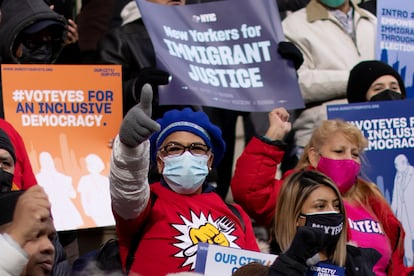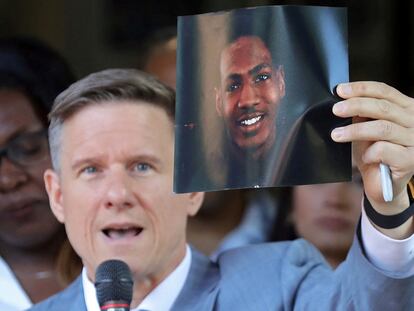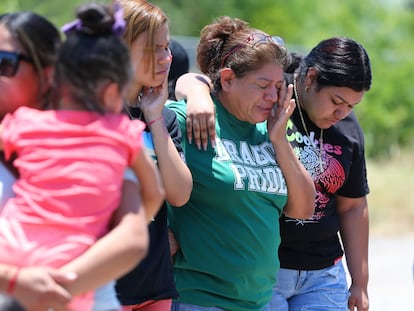The foreign vote hits a Republican wall in New York
Politicians and activists are outraged by the repeal of a law that granted the right to vote to documented immigrants, approved in December by the City Council


As Orlando Sedano, from Colombia, was being sworn in as a US citizen, the New York City Council approved a law allowing documented immigrants (between 800,000 and a million residents in the Big Apple; almost one out of every nine voters), holders of work and residence permits and beneficiaries of asylum or temporary protection, to participate in local elections. It was a groundbreaking decision, and a historic one for the immigrant community in a city forged by foreigners from all over the world. Nonetheless, last week, just six months later, a court in Staten Island – one of the city’s five boroughs – struck down the decision, siding with a group of Republican representatives who believe that the foreign vote dilutes the vote of citizens.
That was the concept used by the judge to explain the repeal of the law, although the official explanation was that the vote of a non-American violates the State Constitution, as only those who can be elected are beneficiaries of active suffrage, and also that a referendum would be required in order to change the system. The regulation, approved by a large majority on December 9, became a law one month later and was going into effect next January. It allowed foreigners to elect not just the mayor and council members, but also other local positions such as the ombudsman and county president, as well as take part in referendums.
“It’s tremendously unfair; such a decision would have been easier to understand in the Donald Trump era, but now…” says an outraged Sedano, watching a supplier unload products in his East Harlem supermarket. “Let’s hope that the promoters of the initiative continue to fight for something that the immigrant community deserves, because it contributes more than it receives from the city, and the city owes a lot of its prosperity and activity, even its functioning, to it. Who kept the city alive during the pandemic? The immigrants, who took many risks, even risking getting sick, to continue to bring us food to our homes, or cleaning the streets or the hospitals for us. It’s a tough, brave and also essential community, as it proved then, and it gets nothing but discrimination in return,” concludes Sedano. That people who pay taxes and “scrupulously” comply with the law, he emphasizes, “have no voice to demand better schools for their children, is outrageous.”
The setback brings a renewed vigor to the Our City, Our Vote campaign, created to reverse a ruling that explicitly certifies the inferior category of the foreigners. “Allowing aliens to vote in New York City violates state law and devalues citizenship,” analyst Hans von Spakosvy said on the conservative network Fox, adding that New York is openly inviting those who are not Americans to model the country’s democracy in the way that benefits them the most, which is unacceptable. It is the same argument that was used by the Staten Island judge – who is of Italian origin, by the way – as well as the main promoters of the complaint, a group of Republican representatives from the same borough.
Mark D. Levine, president of the Borough of Manhattan, does not hide his anger at the repeal of the law, referring to the court’s ruling as “disappointing.” He stated that New York City was built by immigrants, who work and pay taxes there and make it a better place to live for everyone, regardless of their citizenship status, and those nearly one million New Yorkers deserve to participate and have a real voice in the local democracy.
There is a thinly veiled xenophobic bias in the approach of the Republicans who attacked the law: the vote of the immigrants is of lesser quality, and devalues that of the locals. But what if the immigrant in question was an expatriate from the EU? Or an Indian or Japanese professional with accredited financial solvency, living in the Big Apple for work or studies? It appears that those who oppose the law only targeted certain immigrants. The fear of a majority conservative vote was, in fact, the controversial argument put forward by Laurie Cumbo, a former Democratic councilwoman who opposed the law on the grounds that the suffrage of Latinos, many of whom voted for Donald Trump in 2020, could weaken that of African Americans (which she is). The hidden distrust between communities intersects the multifaceted identity of the city, in whose public and political scene the Latinos appear as the last guests to have showed up.
Or the next to last, in fact. On 116th Street, north of Central Park, a group of Senegalese people gather every afternoon outside an African restaurant. They all have a green card (the permanent residence permit), but they didn’t even know about the law that would have allowed them to vote. “We are at the bottom of the ladder. We are below the Latinos, and we have no contact with the African-Americans in the neighborhood, the locals, even though our skin is also black. We are like oil and water, we just don’t mix,” explains Abdou, one of the restaurant’s waiters. “This city is made up of layers and we take up the last one; how are we going to consider voting without even showing ourselves?”
A red-hot political agenda
More than 15 localities across the United States allow non-US citizens to vote, including 11 in Maryland and two in Vermont. San Francisco, in an initiative ratified by the voters in 2016, began allowing non-Americans to vote in school board elections, which was also the case in New York until it abolished those boards in 2002 and gave control of the schools to the mayor. But the approval of the voting law in New York, a traditionally Democratic region, is not only significant because it is the largest city in the country, the one through which many thousands of foreigners entered at the end of the 19th and beginning of the 20th centuries; it is also a counterpoint to the restrictions enacted by states under Republican control, such as Alabama, Colorado, and Florida, which have shielded their legislation in order to prevent such a possibility after denouncing, – without any evidence to back it up – electoral fraud by non-citizens in general elections. Even the terms used in the dispute (citizens versus non-citizens) reveal two very different standards.
That is why the fight is not limited to putting a ballot in a box, the activists maintain. Wennie Chin, director of civic engagement at the New York Immigration Coalition (NYIC), which groups together 200 immigrant associations, warns that democracy is at stake, as the more people vote, the stronger democracy is. Thus, she considers the Staten Island judge’s ruling as, above all, undemocratic. Chin refrains from calling the judge’s ruling racist or xenophobic, but she does describe it as a disappointing decision, albeit one that was expected. However, she points out, New York is much more than Staten Island. The first step will be to appeal the ruling, and they hope to do it successfully.
The small print of the law contains a summary of keys to the red-hot political agenda on the eve of the decisive mid-term elections: the Republican eagerness to limit the right to vote of certain communities; the horizontal racism between communities; the scant political empowerment of Latinos, who make up 29% of the city’s inhabitants, or, in short, the defense of everyone’s political domain: of the constituency, of almost captive voters. The redesign of the electoral map of New York is another factor, and not a minor one, as well as the unrelenting legal fight of the Republicans against any form of social progress. New York, that Babel made of layers, is also a playing field, and its people are contained in watertight categories made up of citizens, residents and aliens.
Tu suscripción se está usando en otro dispositivo
¿Quieres añadir otro usuario a tu suscripción?
Si continúas leyendo en este dispositivo, no se podrá leer en el otro.
FlechaTu suscripción se está usando en otro dispositivo y solo puedes acceder a EL PAÍS desde un dispositivo a la vez.
Si quieres compartir tu cuenta, cambia tu suscripción a la modalidad Premium, así podrás añadir otro usuario. Cada uno accederá con su propia cuenta de email, lo que os permitirá personalizar vuestra experiencia en EL PAÍS.
¿Tienes una suscripción de empresa? Accede aquí para contratar más cuentas.
En el caso de no saber quién está usando tu cuenta, te recomendamos cambiar tu contraseña aquí.
Si decides continuar compartiendo tu cuenta, este mensaje se mostrará en tu dispositivo y en el de la otra persona que está usando tu cuenta de forma indefinida, afectando a tu experiencia de lectura. Puedes consultar aquí los términos y condiciones de la suscripción digital.
More information
Archived In
Últimas noticias
Most viewed
- Reinhard Genzel, Nobel laureate in physics: ‘One-minute videos will never give you the truth’
- Oona Chaplin: ‘I told James Cameron that I was living in a treehouse and starting a permaculture project with a friend’
- Pablo Escobar’s hippos: A serious environmental problem, 40 years on
- Charles Dubouloz, mountaineering star, retires at 36 with a farewell tour inspired by Walter Bonatti
- Why we lost the habit of sleeping in two segments and how that changed our sense of time










































